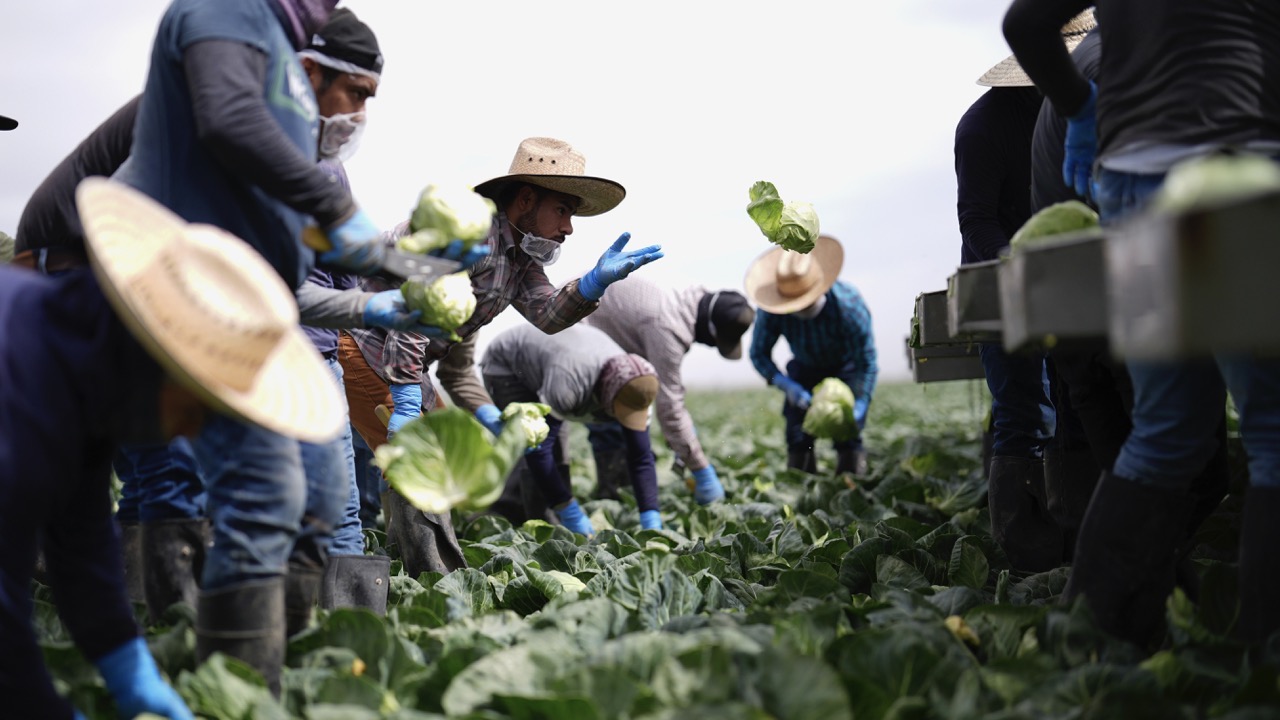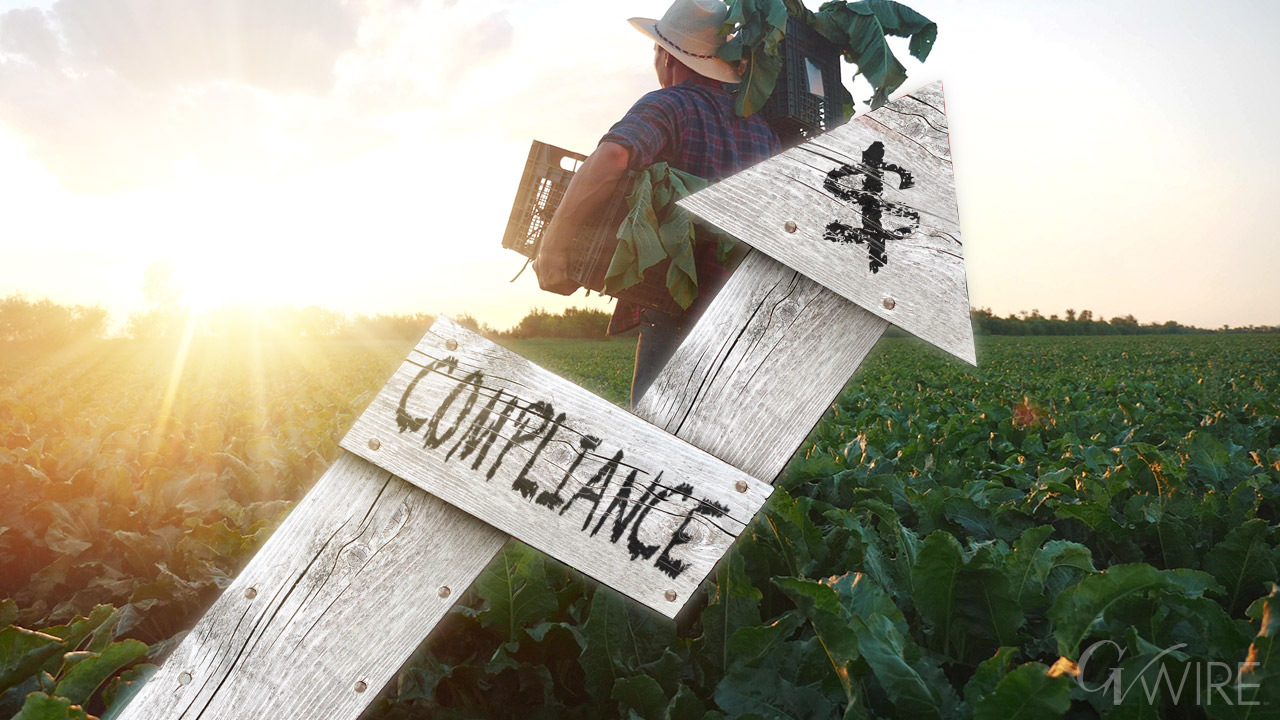A Cal Poly study looked at regulatory costs for a lettuce grower in Salinas going back to 2006. Those costs had risen more than 1,300% by 2024. (GV Wire Composite/Paul Marshall)

- A study from Cal Poly going back to 2006 finds regulatory costs in agriculture have risen 1,300% since then.
- Many regulations have made food safer and added worker benefits while increasing financial pressures on small farmers.
- The number of farms in California dropped by more than 10% from 2017 to 2022, with family farms dipping by 14%.
Share
|
Getting your Trinity Audio player ready...
|
A nearly two-decade study from Cal Poly illustrates just how much regulation costs have grown in farming. And, while many regulations address serious food safety issues and labor costs, the amount farmers pay to do business has increased more than 1,300% since 2006.
All of this while commodity prices have risen nominally.
Fresno County Farm Bureau President Ryan Jacobsen said many regulations have made food safer and contributed to making California the ag capital it is today.
But compliance costs contribute to the “death of a thousand cuts,” he says. The U.S. Department of Agriculture reports continued declines in the number of farms. With rising costs, shrinking profits, and several significant bankruptcies, Jacobsen calls the state of the farming economy the worst since the 1980s.
“Regulation has made our food safer and has led to less illness,” Jacobsen said. “But on the flip side, there is a cost of compliance with every single one of these issues. Maybe a singular issue, that is not necessarily what’s the issue when it comes to the cost side and the effect it has on the farm, but it’s the aggregation or the ‘death by a thousand cuts’ that all of a sudden really starts to amplify.”
Farming Returns Rise .37% From 2017 to 2024. Compliance Costs Up 64%
The January Cal Poly Study commissioned by the Monterey County Farm Bureau looks at a lettuce grower in Salinas. Back in 2006, they looked at that particular farm in a comparison study against other states.
That year, the grower spent $109.15 per acre on regulatory costs, making up about 1.26% of production costs. Workers’ compensation cost the most, taking up about half of regulatory costs, with water quality, food safety, worker education, and training also adding to the rise.
In 2017, researchers followed up with the grower. That year, regulatory costs grew to $977.30 per acre, or 8.9% of total production costs. Shortly after the 2006 study, an E. coli outbreak in spinach added safety measures for growers.
In that time, new environmental and worker wage and safety laws also came into effect, the study stated.

While production costs in general rose by 24.8% in those years, regulatory compliance skyrocketed by 795%.
That trend continued when in December 2024, researchers again followed up with the grower. By that year, compliance cost $1,600 an acre, comprising 12.6% of production costs. That marked a 63.7% increase in compliance costs from 2017 and a 1,366% increase from 2006.
Food prices have not climbed at the same rate.
The lettuce farmer received about $8,637 per acre for his product in 2006 and climbed to $12,415 by 2017, according to the report. However, per-acre income had only grown to $12,461 by 2023.
20 Laws/Updates Since 2006 Contribute to Rising Costs
The study identifies 20 new laws or updates raising costs to farmers. They include food safety, air and water quality, labor health and safety, and wages.
Laws required shade and water for employees, as well as health insurance and overtime pay.
Worker training also consumed more time. Workers must participate in food safety and pesticide training for 30 minutes every two weeks. Workplace violence prevention training and sexual harassment training also occurs regularly.
Training the trainer has its own costs — about $1,250 every year for the human resources manager.
Well monitoring and caps on diesel emissions began. The 2014 Sustainable Groundwater Management Act came into effect in those years, adding significant costs to water.
Regulators also imposed more food safety tracking rules. Given how leafy greens are grown and eaten — close to the ground and often served raw — they are on the higher side of food safety requirements, Jacobsen said.
“But nevertheless, I would expect so many (Central Valley) crops to be in the same boat when it comes to the regulatory costs that are associated with growing these crops,” Jacobsen said.

Regulations Have an Outsized Impact on Small Farms
A few years ago, Jacobsen compiled a list of 60 local, state, or federal agencies a farmer could have to deal with.
More recently, one farmer told Jacobsen his list had grown to 90.
The issue came to a head in 2024 when avian flu made its way through the Central Valley. Many dairy farmers told GV Wire they didn’t know whether they were supposed to answer to the California Department of Food and Agriculture or the U.S. Department of Agriculture. The U.S. Centers for Disease Control and Prevention also weighed in on the human side of the infection.
Related Story: Special Report: Avian Flu Is Devastating Dairies in California’s Central ...
Don Cameron, owner of Terra Nova Ranch near Fresno, said keeping up with compliance can be hard, especially on smaller growers. Cameron said when he has an issue, he can hire an attorney.
“But I worry about the small and medium growers that are faced with many of the rules that they’re required to follow, and I think it’s harder on a small grower to keep up with regulations,” Cameron said.
Those impacts can be seen in California. Farms in the state declined by more than 10% from 2017, according to the USDA’s 2022 farm census. The number of family or individually run farms decreased by 14%. Meanwhile, the number of corporately run farms increased by 11%.
Jacobsen said streamlining ag regulations would greatly help reduce cost and time spent working through compliance.
“There just needs to be a lot more collaboration between the agencies up in Sacramento and in D.C. to try to find way to streamline as much of this as possible to where the perceived benefit that the government is looking for is still received or close to received,” Jacobsen said. “But on the flip side, ag finds a way to not have to bear the full brunt of what we are experiencing right now.”




















